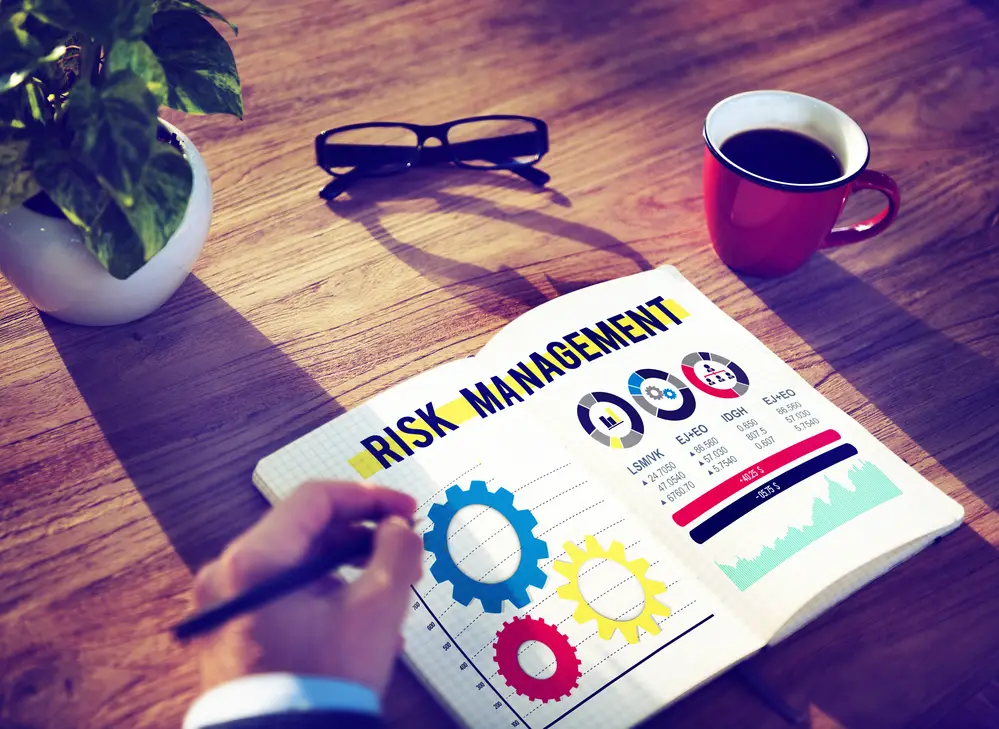From natural disasters to financial risks, there are all types of risks that businesses face daily. While it’s impossible to predict the future or prevent all risks from happening, risk management is an essential process that can help you identify, assess, and respond to potential risks to minimize the negative impact on your business.
Not sure where to start? Don’t worry; we’ve got you covered. Below are four risk management examples that every business should be aware of.
- Develop a Business Continuity Plan
An important risk management example is developing a business continuity plan (BCP). A BCP is a plan that outlines how your business will continue to operate during an interruption, such as a power outage, natural disaster, or supply chain disruption.
Developing a BCP isn’t something you can do overnight. It requires careful planning and consideration of all the potential risks your business could face. However, developing a comprehensive BCP can save your business a lot of money and headaches. This reduces safety risks.
- Review Your Insurance Coverage Regularly
Another important risk management example is reviewing your insurance coverage regularly. As your business grows and changes, so does your risk exposure. What may have been sufficient coverage for your business five years ago may no longer be adequate today.
By reviewing your customer credit risk management regularly, you can ensure that you have the right policies in place to protect your business from potential liabilities. You should also remember that insurance coverage is not always free; sometimes, you may need to pay higher premiums for certain types of coverage.
However, paying a few extra dollars can save you thousands in the long run if something unfortunate happens. This reduces contract risk. Insurance is a risk transfer risk management strategy and also regulatory compliance.
Contracts are also used in risk management. A contract is basically a legally binding agreement between two parties. Contracts can be used to transfer risks from one party to another, and insurance will be a risk mitigation mechanism. Payment of insurance premiums is crucial for critical risks.
For example, if you hire a contractor to build a new addition to your home, you may include a clause in the contract that states that the contractor is responsible for any damages that occur during the construction process.
- Conduct Regular Employee Training
Employees are one of the most important assets of any business. They are also one of the biggest sources of risk. That’s why conducting regular employee training on risk management procedures and protocols are so important. Employees will participate in risk management activities.
Risk Management programs will ensure that all employees are up-to-date on company procedures, and you can minimize the chances of human error or negligence causing problems for your business. You should also make sure to conduct background checks on all new hires to verify that they are qualified and trustworthy individuals who will not put your company at risk.
Employees will be able to understand risk management processes and be able to do risk identification and thorough risk analysis.
- Implement Cybersecurity Measures
In today’s digital world, cybersecurity is more important than ever before. Hackers are constantly trying to find new ways to break into companies’ systems and steal sensitive data, such as customer information or financial records. Risk management software might introduce external risks.
All businesses, no matter their size or industry, are at risk for cyberattacks. That’s why it’s so important to implement strong cybersecurity measures, such as firewalls and encrypted data storage. Through a risk management plan to protect your data, you can minimize the chances of suffering a devastating breach that could jeopardize the future of your business.
The importance of managing risk is more critical in today’s turbulent risk environment. Ten risk management strategies will prepare you to face volatile risk landscapes.
When the Bank’s branches were closed, they altered customer interactions and forced changes to long-held risk-management practices to control existing risks and protect new ones.
Identifying risks will influence whether companies and institutions can recover, which is necessary to rethink risks and risk control. Information security risk and cybersecurity risks are high risks for banking institutions.
There is no easy way to reduce the risk to a certain extent. After analyzing the risk, the risk can be nullified by the method used in the process. There is a need to learn about risk prediction. This situation is mainly related to business in which Risk Management has the most importance.
Risk exists across every field of business. Organizations in different sectors need to know how to manage risk. Businesses can face different problems and priority areas when evaluating their risks.

Examples of risks and risk management techniques
1. Financial risks.
These risks could lead to financial losses for your business, such as investing in a new product line that doesn’t sell or taking out a loan with unfavorable terms. To mitigate financial risks, be sure to conduct thorough market research before making any big decisions and always consult with a financial advisor to get expert advice. Market risk is a subset of an example of financial risk.
For small businesses, financial risk is a significant risk that also bedevils financial institutions. Project managers need to be aware of existing maintenance processes that might result to high risk.
2. Compliance risks.
These risks could lead to your business being out of compliance with laws and regulations, resulting in hefty fines or even jail time for you and your employees. To mitigate compliance risks, ensure you’re up-to-date on all relevant laws and regulations and have a compliance officer on staff responsible for monitoring compliance and implementing best practices.
3. Operational risk.
These risks could disrupt the normal operation of your business, such as a power outage or severe weather conditions. To mitigate operational risks, have contingency plans in place so you can continue operating even if something unexpected happens. For example, you might want to invest in backup generators and keep extra inventory on hand in case of a supply chain disruption.
4. Reputational risks.
These risks could damage your business’s reputation, including negative publicity or data breaches. To mitigate reputational risks, regularly monitor your online presence and implement procedures to handle negative publicity if it arises. You should also invest in data security measures to protect your customer’s information from hackers.

Risk Management Examples as per Risk Descriptions
Many approaches can be taken. For instance, if a company faces the risk of a natural disaster disrupting production, it may invest in backup generators or build its facilities in safer locations.
On the other hand, if the risk is a cyber attack compromising sensitive customer information, they may invest in stronger security measures and regular employee training on cybersecurity best practices.
Another example could be the risk of a faulty product causing injury to consumers; in this case, a company might conduct extensive testing and quality control measures before releasing the product to the public.
The key is to identify potential risks and develop specific strategies to address them effectively. By taking proactive steps to manage risks, a business can protect its reputation and financial stability in the long run.
Risk of vendors not fulfilling their commitments
It’s a principle that reflects a principle that multiplies all interactions with other parties by three. The worst situation can be when many suppliers use the same product for one product. If the deliverability depends on another person, it’s impossible to rely on their schedule. Delays continue to occur.
It is later that you complete the job. It looks like this deliverable will never function. Those who have vacations can’t fix their problem. The next defect may occur when the application is integrated. It must be fixed; you’re going to waste everything you’re trying to achieve. All right. Add overheads of communications, thin control, and inability to integrate with another program.
Uncertainty in project scope
It is possible that the risks affected the scope. It may just be another case for technology and integrated risk management. Enterprise software was very complex but extremely valuable. Rather than describe the whole process in more detail, it was necessary to update the system. From start to finish, it’s been clear that this is a huge project.
Usually, a project manager might have an answer. Is this worth buying myself? However, you may want it integrated into your software and customized. The module can be plugged in. So it goes on. Maybe you want it: buy it and make specialized changes as much as possible to make it work. It’s possible that there’s no cost-efficiency decision.
Risque of Uncertain Requirements
Having clear, concise, and realistic requirements for any project is important. The more detailed they are in the scope statement-the better chance you will have that all aspects can be addressed with this document, but don’t worry if it’s not perfect because we’re here at your service!
Project Risk Management Examples with sick leave
Normally the case would have to be handled for a given project by default if the scenario were to occur. It shows how common sense can be used. Risk management isn’t always a skillful project management tactic.
The risk manager will identify project risks, including critical and other external risks, and all risk response ownership lies with the project manager.
It was incredibly crucial work. The deadline was tight. We had to evaluate our scope to be ready before we released everything to complete it. And that is Autumn. The weather changed significantly. Traditional organizations’ sick leaves are an annual event. The project manager’s role in risk management is crucial for the effective risk management of projects.
Importance of Risk management
Risk management is crucial as it allows companies to efficiently identify and manage potential risks. Once identified, the risks will be reduced quickly. Risk management also gives a company a basis for making informed decisions, and management is the process.
Management is the most effective way of planning events that could impede development. The better an organization’s ability to deal with potential risks is to develop and implement the structures required to manage these problems.
Progressive Risk Management ensures rapid and effective resolution of hazardous situations of the highest priority through qualitative risk analysis.
Risk Management Studio
It is an increasingly complex risk management application that uses a variety of tools in many different fields. Gap analyses, risk assessments with treatment, BusinessContinuity Manager, and Risk Assessments with Treatment are the included products.
It was rated ISO27001, and therefore, the threat database was massive. There will be two main advantages: the installations are easy, and there are free upgrades and help besides the annual cost. Learning RM Studio is very easy to use right away. Most of us use Excel sheets frequently. This support both the import and export of Excel files in RM Studio.
Information security risks
It reflects security. Data has immense value for businesses that needs safeguarding. Data theft can take many forms and present a major business problem. Controlling email and any communication is a possible way to minimize this major risk.
They need to undergo screening so no doubtful persons are entering the business, and if they do, they must go through appropriate procedures accordingly. Many more examples of a Risk Management approach can be used in our transition from industry to industry. This leads to a growing number of ways to control these hazards.
Industry-specific strategy
Taking manufacturing as an example. The company’s new product has been designed. The company needs to perform an extensive risk analysis to identify any significant risks it can experience before beginning production.
They evaluate whether this product has advantages beyond the risks that are associated.
Risk Avoidance
It’s easy for investors to describe risk avoidance using a case study in which they are aiming at managing risk in their investments. If an investor loses money by selling his/her investments or putting money into a new company, the investor can take it away, which is called risk avoidance. Risk avoidance is one of the risk response mechanisms.
Risk Example of Incorrect Requirements
We assumed we knew our end users’ requirements. Although, our users have specific needs and severe fine motor movement difficulties. Of course, the implementation method is diverse. It was not a gamble.
Example of Risk Management with Inefficient Quality
It shows how implementing change processes helps mitigate risks. So my team was largely unexperienceable. They were very competent in completing the task. Because the product is complex, the defects are quite large,
However, depending on how things change, defects accumulate and multiply. They significantly affected our schedules. We just added a reserve to our risk. But that’s just speculative speculation; it is unreliable. The complexity of finding the correct application increases with its complexity.
The 5-step process of Risk management
Almost everything involved in a risk management program has five steps, but the terminology differs. Together these five risk management procedures form a comprehensive risk management system. It’s here that you get started on creating a Risk Register. Once risk is defined, it is important to determine risk and its consequences evaluated.
Risk management is the proactive identification, assessment, and prioritization of risks, followed by developing and implementing appropriate risk mitigation strategies. The goal is to reduce the impact of risks on organizational objectives. Risk management is a continuous process that should be revisited regularly to ensure that risks are managed effectively.
There are five steps in the risk management process:
- Identification: This step involves identifying potential risks to the organization. Risks can come from internal or external sources and can be related to business operations, financials, technology, or people.
- Assessment: Once risks have been identified, they need to be assessed to determine their severity and likelihood of occurrence. This helps prioritize which risks need to be addressed first.
- Mitigation: Once risks have been prioritized, strategies must be developed to mitigate them. This may include developing policies and procedures, putting controls in place, or training employees on how to respond to a risk event.
- Monitoring: It is important to continually monitor risks to quickly address any new or changing threats. This may involve tracking data points such as financial performance or website traffic or using software that scans for vulnerabilities.
- Review: The risk management process should be periodically reviewed to ensure that it is still effective and meets the organization’s needs.
What is the most common Risk Response
Risk management involves implementing varying strategies to mitigate risk. Not everyone is in a position of need. You probably remember ‘avoidance’ as an adage. Obviously, in assessing risks and reducing them to manage their impact, avoidance has become an effective strategy that reduces acceptance and carries out transfers.
Avoiding risks
Avoidance prevents any risk from forming into reality or presenting itself completely. If the product is not functioning as expected and is not posing risk to the employee’s safety, it can cause the best outcome to avoid the danger.
Using faulty equipment is another example. Avoidance can be avoided without causing any problems. Ultimately this response needs to be revised to find alternatives that address deeper problems.
Mitigating Risks
Mitigating risks is commonly viewed as a risk management option. Often ignoring or accepting risk can be a more effective solution. If an incident causes expensive negative impacts for the employee or the customer, it needs to be mitigated.
This involves identifying risks, evaluating the available options, developing plans for the actions needed, and evaluating the results.
Accepting risks
Sometimes avoidance is not the most efficient answer. Acceptance is the best practice for some situations. When risks may not arise or the impact is minimal, taking the risk is a reasonable response.
Depending on the risk, timing is also considered. One of those examples may be changes in pricing from vendors. It’s essential that we periodically evaluate such risks.
Transfer of risk
Sometimes challenges arise that your team cannot overcome or can’t overcome. Some examples lack the knowledge or skills necessary to manage these risks. Outsourcing or transferring risks to another party; in-house and occasionally, external assistance may be needed.
Conclusion
There are many different types of risks that businesses face daily. While it’s impossible to predict the future or prevent all risks from happening, risk management is an essential process that can help you identify, assess, and respond to potential risks to minimize the negative impact on your business.
Developing a comprehensive Risk Management strategy is vital for any business looking to protect itself from potentially devastating losses. Take some time today to review the four risk management examples above and see how you can implement them in your own business. Doing so could save you a lot of money—and headaches —down the road.

Chris Ekai is a Risk Management expert with over 10 years of experience in the field. He has a Master’s(MSc) degree in Risk Management from University of Portsmouth and is a CPA and Finance professional. He currently works as a Content Manager at Risk Publishing, writing about Enterprise Risk Management, Business Continuity Management and Project Management.

